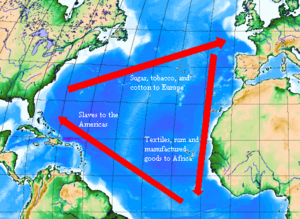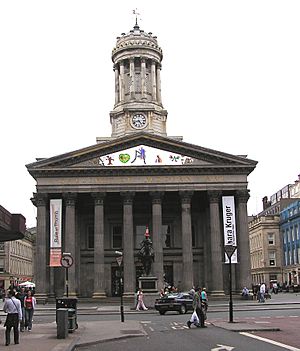Tobacco Lords facts for kids
The Tobacco Lords were a group of rich Scottish merchants in the 1700s. They made huge amounts of money by trading tobacco with the English Colonies in North America. This trade was heavily supported by the Atlantic slave trade, which used enslaved people for labor. Many of these merchants became so wealthy that they started living like British aristocrats, spending vast sums on grand houses and beautiful churches.
Contents
History of the Tobacco Trade
In 1707, Scotland and England joined together with the Treaty of Union. This agreement gave Scottish merchants access to England's colonies, especially in North America. Glasgow was in a great spot on the River Clyde for this trade. Its location meant ships could easily catch the westerlies winds to cross the Atlantic.
In 1747, the French king even gave Glasgow a special right to bring tobacco into French lands. The Clyde River was made deeper in 1768, which was another big help. Glasgow ships were built specifically for long trips across the Atlantic and were often bigger than ships from other ports.
The tobacco trade was part of a larger system. This system connected goods from Europe with the colonies in North America and the Caribbean. These colonies grew products like tobacco using slave labor. These products were then sold in Europe. This was often called the "Triangular Trade."
Here's how it worked:
- Merchants took manufactured goods from Europe to West Africa.
- There, they sold or traded these goods for enslaved people.
- They then transported the enslaved people to America and the Caribbean.
- Finally, they carried tobacco, rum, cotton, and sugar back to Europe.
From 1710, Glasgow saw a huge economic boom that lasted almost 50 years. The Tobacco Lords were the perfect example of this boom. They were the "new rich" of the mid-1700s.
One of the most successful merchants was John Glassford. He started in the tobacco trade in 1750. Soon, he owned many ships and tobacco stores across New England. People at the time celebrated Glassford. He owned more ships than anyone else in Scotland during his time. He was one of four merchants who helped make Glasgow a major trading city through tobacco.
In 1771, a writer named Tobias Smollett met Glassford and wrote:
I talked with Mr G--ssf--d, who I think is one of the biggest merchants in Europe. During the last war, he was said to own twenty-five ships and their goods at one time. He traded for more than half a million pounds sterling a year.
Grand Homes and Churches
Glasgow merchants made so much money that they started living like nobles. They had fancy manners and built lavish homes and churches. However, because of their Calvinist background, their displays of wealth were often rich but simple. They wore black silk clothes, sometimes with bright red cloaks. They had black three-cornered hats, and walking sticks with silver or gold tips made of ebony. Their furniture was made of mahogany, and their buildings used classical architecture.
Their large houses were built on the western edge of Glasgow in the 1700s. Many of these streets are now in an area called the Merchant City. Other streets still remind us of the triangular trade, like Virginia Street and Jamaica Street.
Some important Tobacco Lords whose houses gave names to streets include Andrew Buchanan, James Dunlop, Archibald Ingram, James Wilson, Alexander Oswald, Andrew Cochrane, and John Glassford. The grand house of Alexander Speirs gave Virginia Street its name. Alexander also gave his last name to Speirs Wharf in Port Dundas.
You can still see how grand these houses were in Glasgow today. The Gallery of Modern Art is in a building that was once the mansion of William Cunninghame. It was built in 1780 and cost £10,000, which was a huge amount of money back then. A smaller house, the Tobacco Merchant's House, built in 1775, is being restored at 42 Miller Street.
St Andrew’s Parish Church was built between 1739 and 1756. It was the Tobacco Lords' very showy church, located in a fancy area. This church was the first Presbyterian church built after the Reformation. The city's Tobacco Lords paid for it to show off their wealth and power.
Today, St Andrew's in the Square is still standing. It's considered one of the most beautiful classical churches in Britain. Now, it's Glasgow's Centre for Scottish Culture, where people enjoy Scottish music, songs, and dance.
The American Revolution and Tobacco
During the 1760s, problems grew between Britain and its American colonies. One big issue was the tobacco trade. The colonists felt the Glasgow merchants were unfair. They claimed the merchants controlled prices, which caused big problems for tobacco farmers in Maryland and Virginia. By the time the war started, these farmers owed about £1 million to the merchants. This was a massive amount of money.
These debts were a major reason for the colonists' anger, just as much as the taxes from Britain. The Glasgow merchants were different because they offered cheap loans. English merchants simply sold American tobacco in Europe and took a fee. The Scottish merchants bought the tobacco at set prices and gave large (and risky) loans to the farmers.
Before 1740, Glasgow merchants imported less than 10% of America's tobacco. But by the 1750s, Glasgow handled more tobacco trade than all other British ports combined. These merchants had a lot of money and took big personal risks. They made huge fortunes from their "Clockwork Operation" of fast ships and tough business deals.
Farmers in Maryland and Virginia were offered easy loans by the Glasgow merchants. This allowed them to buy European goods and luxuries before they had cash from their harvest. But when it was time to sell their tobacco, the farmers found themselves forced to accept low prices. This was to avoid going bankrupt because of their debts.
George Washington, who would become the first President of the United States, saw his debts grow to nearly £2,000 by the late 1760s at his Mount Vernon farm. Thomas Jefferson was almost losing his own farm. He accused British merchants of unfairly lowering tobacco prices. He said they forced Virginia farmers into debts they couldn't pay.
In 1786, Jefferson wrote:
A powerful way they did this was by giving good prices and loans to the farmer. They kept giving credit until the farmer owed more than he could pay without selling land or enslaved people. Then they lowered the prices for his tobacco. This way, they never let him pay off his debt.
After the American Revolutionary War (1775–1783), most of these huge debts owed by the colonists were never paid back. Despite these problems, the Glasgow merchants quickly found other profitable parts of the triangular trade. They focused especially on cotton in the British West Indies.
Legacy in Glasgow
The Tobacco Lords had a lasting impact on Glasgow's buildings. St Andrew's in the Square is now Glasgow's Centre for Scottish Culture. It promotes Scottish music, song, and dance. William Cunninghame's grand mansion now houses the Glasgow Gallery of Modern Art.
Notable Tobacco Lords
- George Bogle of Daldowie
- Andrew Buchanan of Drumpellier
- Andrew Cochrane of Brighouse
- Andrew Caskie of Kilcreggan
- William Cunninghame
- James Dunlop
- John Glassford
- Archibald Ingram
- Logan Lowe of Aberdeen
- Alexander Oswald
- Alexander Speirs
See also
- History of Maryland in the American Revolution
- Fur Barons of Montreal




